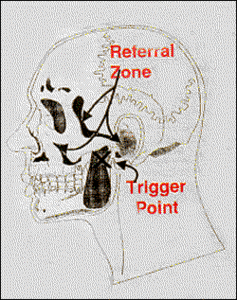Last month we took a look at a patient with an interesting cluster of head pain complaints. Two factors made this case worthy of our attention: first was its classic clinical presentation and, second, a patient with this kind of problem is likely to present to a chiropractor.
Did you develop a clinical impression and what procedures did you decide to incorporate into your examination of Rick (our patient) to confidently rule-in or rule-out your suspicions? (Let's assume we already have conducted the examination procedures we routinely use in the course of the examination of a new patient.) What examination procedures are specifically indicated from Rick's chief complaint and history? Hint: The indicated procedures are logically attached to our clinical impressions.
We asked him about his joint pain. Rick reports that the pain is focal and is aggravated when he chews and it feels sharp at times, but mostly it is a dull ache which he presently experiences. After prompting, he points to the painful site. If Rick probes the site lying one inch in front of the ear and one-half inch below the zygoma, he reports the pain feels deep and worsens with digital pressure. Impression: possible myofascial trigger point in the deep head of the masseter. Rule-in by: digital examination of the site of focal pain and test for the clinical signs of a trigger point.

What about the headaches? Rick reports that he now gets headaches that occupy the area around the right ear and below the right eye. He says that he only gets these headaches when his jaw pain worsens, which is usually after eating but sometimes when he wakes up in the morning. Impression: heterotrophic pain (referred pain) associated with the trigger point in the deep masseter. Rule-in by: provoking the associated trigger point (see above) and observing for elicitation of "headache" (a referred pain). Also, examine for associated trigger points which are likely to develop in the right temporalis. (Figure 1)
We were especially interested in the sudden change in his bite. (If you have taken the temporomandibular [TM] seminar, you better not miss this important diagnostic clue.) Rick states that his teeth do not touch on the right side now. He adds that his front and back left teeth touch, but not like they used to. When we pursue this point, we discover that he can actually get his teeth to touch properly, but at the expense of considerable pain. Rick points to the painful area lying just in front of the tragus of the ear which he describes as superficial rather than deep. We also find that he prefers to chew on the right side even though his teeth do not touch because chewing on the left side aggravates his complaint. Impression: increased intracapsular pressure possibly due to retrodiscitis or capsulitis. This also explains the joint "popping" Rick complained of -- which is a sign of disc-condyle incoordination induced by the changes in the intracapsular environment. Rule-in by: applying the distraction/compression tests which isolate capsulitis from retrodiscitis.
When pursuing Rick's jaw pain we found out that two months prior to the onset of pain, his upper right wisdom tooth erupted errantly -- pointing sideways towards his cheek. Rick still has the wisdom tooth. Impression: ectopic eruption of the right upper right third molar. Rule-in by: arranging for a dental evaluation.
Is the problem chiropractic or dental?
If you answered both, it is likely that your practice is set up to handle these types of head pain problems. More than likely you would have managed most of Rick's complaints excepting, of course, the extraction of the molar. This is assuming Rick responded very well to treatment. We could go on forever developing contingency plans if we assume otherwise.
By the way, we are especially concerned with one of the diagnoses because it puts Rick at risk for another type of troublesome TM disorder. Did you remember to include this? We are most concerned with the capsulitis because it puts Rick at risk for intracapsular adhesion formation, and contracture of the capsule. You may also remember that appropriate and carefully applied adjustments to the TM joint are a necessary part of Rick's overall treatment and an appropriate method of preventing discal adhesions or contracture of the capsule.
With each article I encourage you to write the questions you may have, commentaries on patient care subsequent to attending the TM seminars, or thoughts to share with your colleagues, to me:
Darryl Curl, D.D.S., D.C.
2330 Golden West Lane
Norco, California 91760
Please enclose your return addressed, stamped envelope.
Editor's Note:
Dr. Curl will be teaching MPI's Temporomandibular ("TM") seminar on February 1-2, 1992 in Davenport, Iowa. You may register for the seminar by dialing 1-800-327-2289.




